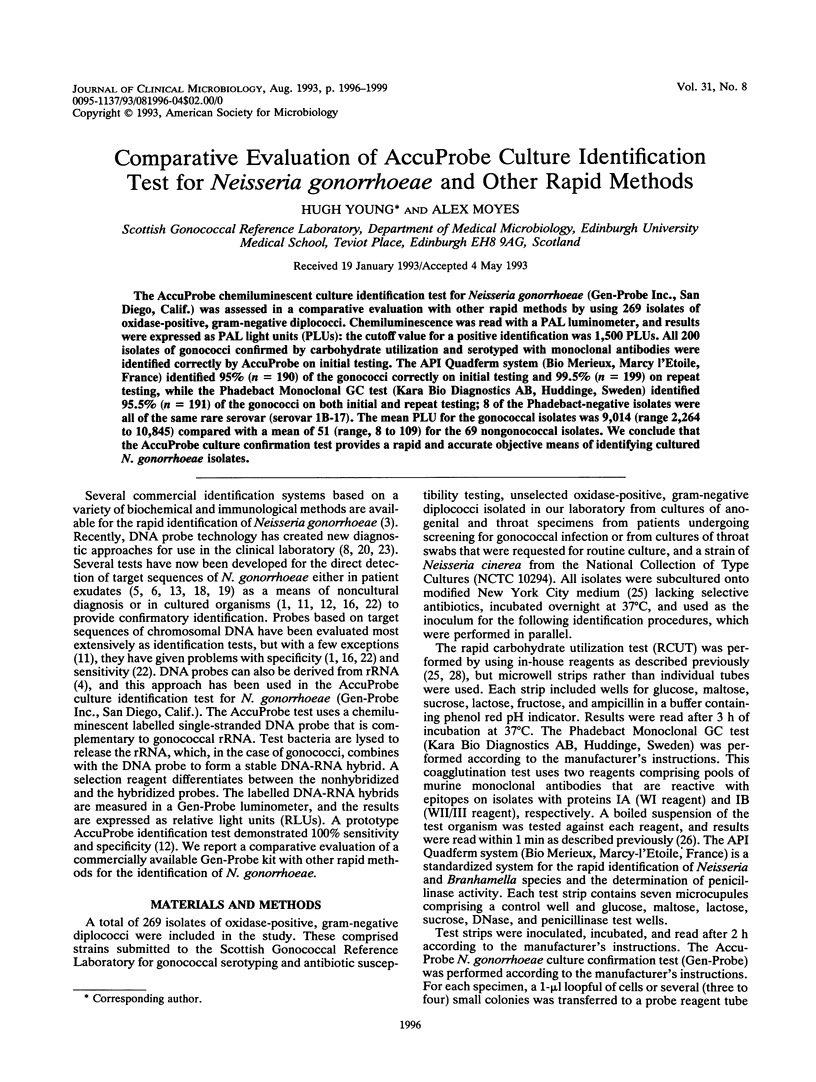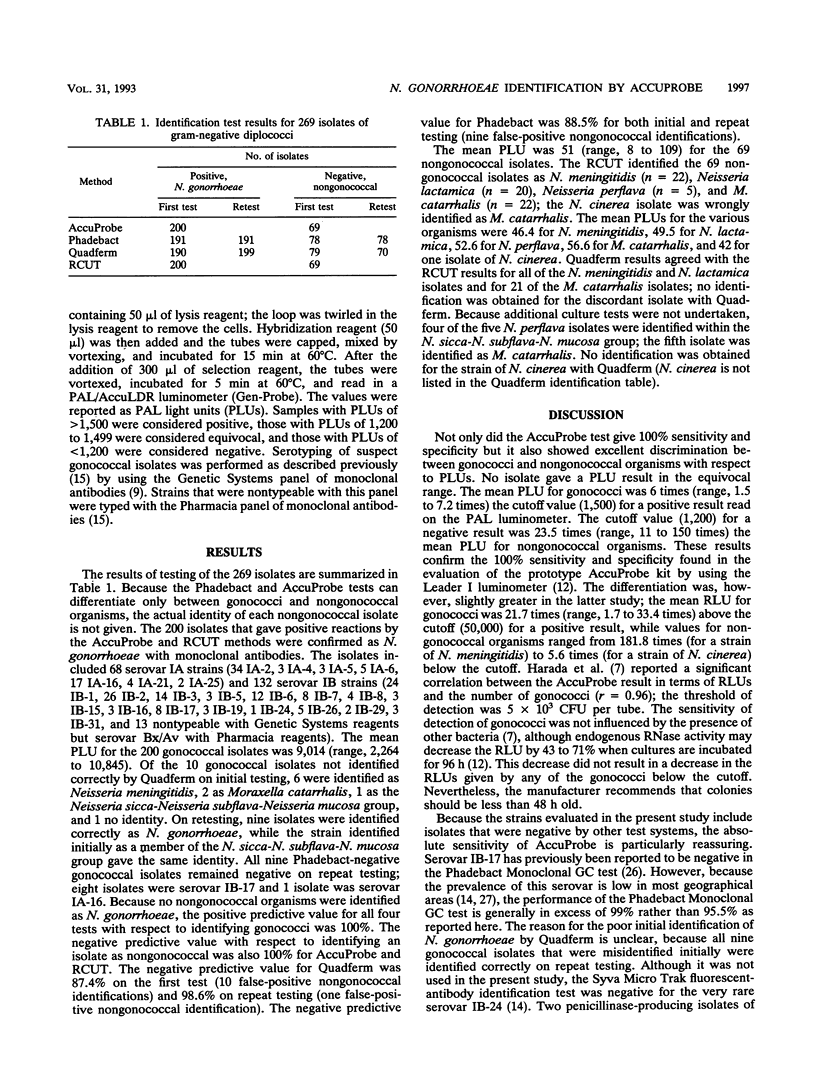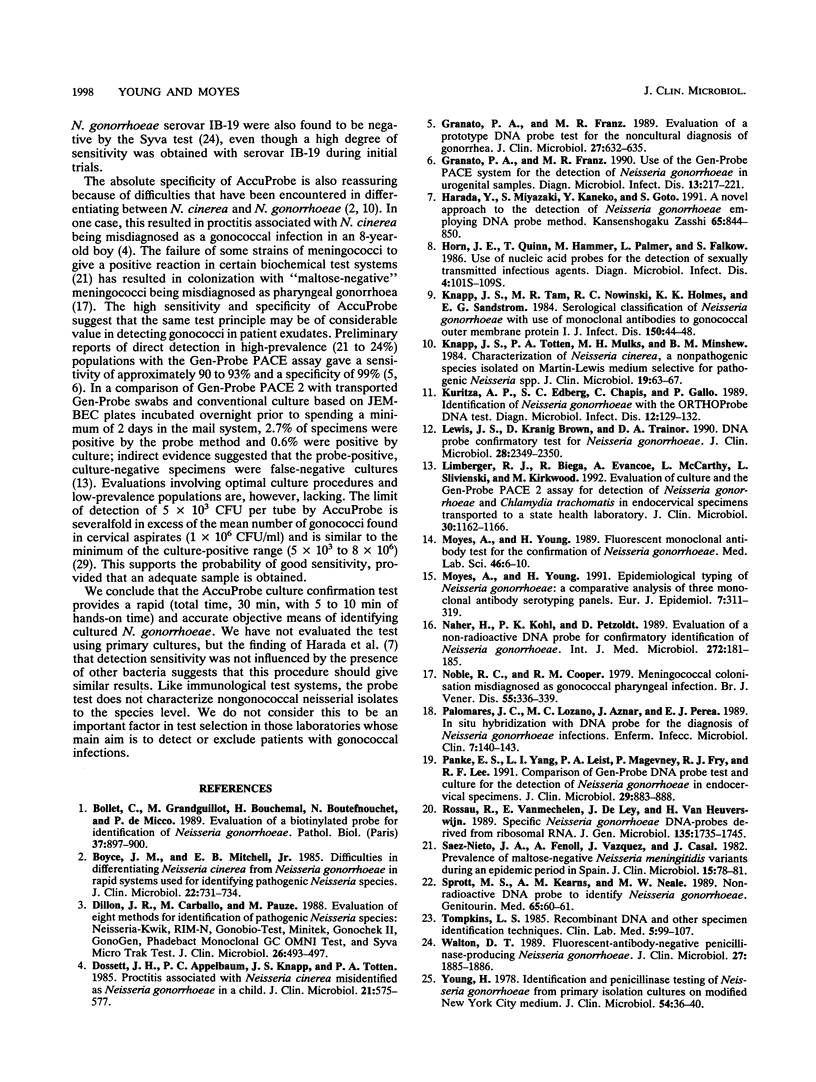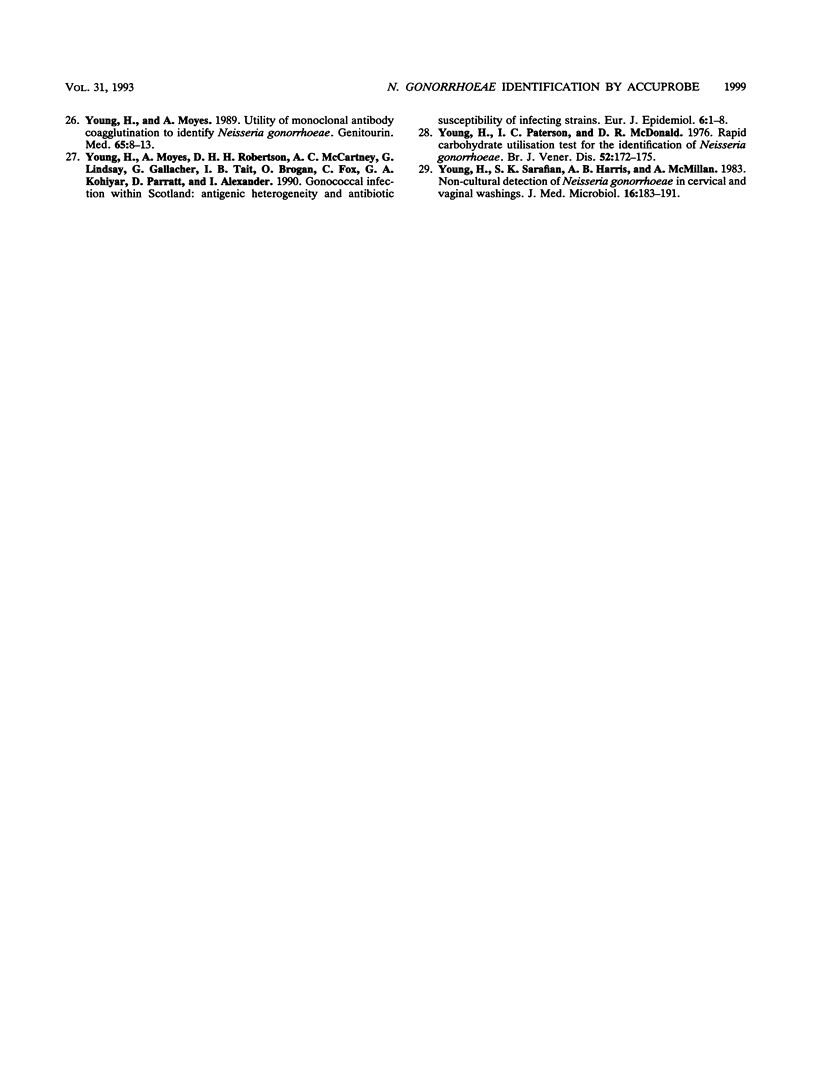Abstract
The AccuProbe chemiluminescent culture identification test for Neisseria gonorrhoeae (Gen-Probe Inc., San Diego, Calif.) was assessed in a comparative evaluation with other rapid methods by using 269 isolates of oxidase-positive, gram-negative diplococci. Chemiluminescence was read with a PAL luminometer, and results were expressed as PAL light units (PLUs): the cutoff value for a positive identification was 1,500 PLUs. All 200 isolates of gonococci confirmed by carbohydrate utilization and serotyped with monoclonal antibodies were identified correctly by AccuProbe on initial testing. The API Quadferm system (Bio Merieux, Marcy l'Etoile, France) identified 95% (n = 190) of the gonococci correctly on initial testing and 99.5% (n = 199) on repeat testing, while the Phadebact Monoclonal GC test (Kara Bio Diagnostics AB, Huddinge, Sweden) identified 95.5% (n = 191) of the gonococci on both initial and repeat testing; 8 of the Phadebact-negative isolates were all of the same rare serovar (serovar 1B-17). The mean PLU for the gonococcal isolates was 9,014 (range 2,264 to 10,845) compared with a mean of 51 (range, 8 to 109) for the 69 nongonococcal isolates. We conclude that the AccuProbe culture confirmation test provides a rapid and accurate objective means of identifying cultured N. gonorrhoeae isolates.
Full text
PDF



Selected References
These references are in PubMed. This may not be the complete list of references from this article.
- Bollet C., Grandguillot M., Bouchemal H., Boutefnouchet N., de Micco P. Evaluation d'une sonde biotinylée pour l'identification de Neisseria gonorrhoeae. Pathol Biol (Paris) 1989 Oct;37(8):897–900. [PubMed] [Google Scholar]
- Boyce J. M., Mitchell E. B., Jr Difficulties in differentiating Neisseria cinerea from Neisseria gonorrhoeae in rapid systems used for identifying pathogenic Neisseria species. J Clin Microbiol. 1985 Nov;22(5):731–734. doi: 10.1128/jcm.22.5.731-734.1985. [DOI] [PMC free article] [PubMed] [Google Scholar]
- Dillon J. R., Carballo M., Pauzé M. Evaluation of eight methods for identification of pathogenic Neisseria species: Neisseria-Kwik, RIM-N, Gonobio-Test, Minitek, Gonochek II, GonoGen, Phadebact Monoclonal GC OMNI Test, and Syva MicroTrak Test. J Clin Microbiol. 1988 Mar;26(3):493–497. doi: 10.1128/jcm.26.3.493-497.1988. [DOI] [PMC free article] [PubMed] [Google Scholar]
- Dossett J. H., Appelbaum P. C., Knapp J. S., Totten P. A. Proctitis associated with Neisseria cinerea misidentified as Neisseria gonorrhoeae in a child. J Clin Microbiol. 1985 Apr;21(4):575–577. doi: 10.1128/jcm.21.4.575-577.1985. [DOI] [PMC free article] [PubMed] [Google Scholar]
- Granato P. A., Franz M. R. Evaluation of a prototype DNA probe test for the noncultural diagnosis of gonorrhea. J Clin Microbiol. 1989 Apr;27(4):632–635. doi: 10.1128/jcm.27.4.632-635.1989. [DOI] [PMC free article] [PubMed] [Google Scholar]
- Granato P. A., Franz M. R. Use of the Gen-Probe PACE system for the detection of Neisseria gonorrhoeae in urogenital samples. Diagn Microbiol Infect Dis. 1990 May-Jun;13(3):217–221. doi: 10.1016/0732-8893(90)90062-z. [DOI] [PubMed] [Google Scholar]
- Harada Y., Miyazaki S., Kaneko Y., Goto S. [A novel approach to the detection of Neisseria gonorrhoeae employing DNA probe method]. Kansenshogaku Zasshi. 1991 Jul;65(7):844–850. doi: 10.11150/kansenshogakuzasshi1970.65.844. [DOI] [PubMed] [Google Scholar]
- Horn J. E., Quinn T., Hammer M., Palmer L., Falkow S. Use of nucleic acid probes for the detection of sexually transmitted infectious agents. Diagn Microbiol Infect Dis. 1986 Mar;4(3 Suppl):101S–109S. doi: 10.1016/s0732-8893(86)80048-7. [DOI] [PubMed] [Google Scholar]
- Knapp J. S., Tam M. R., Nowinski R. C., Holmes K. K., Sandström E. G. Serological classification of Neisseria gonorrhoeae with use of monoclonal antibodies to gonococcal outer membrane protein I. J Infect Dis. 1984 Jul;150(1):44–48. doi: 10.1093/infdis/150.1.44. [DOI] [PubMed] [Google Scholar]
- Knapp J. S., Totten P. A., Mulks M. H., Minshew B. H. Characterization of Neisseria cinerea, a nonpathogenic species isolated on Martin-Lewis medium selective for pathogenic Neisseria spp. J Clin Microbiol. 1984 Jan;19(1):63–67. doi: 10.1128/jcm.19.1.63-67.1984. [DOI] [PMC free article] [PubMed] [Google Scholar]
- Kuritza A. P., Edberg S. C., Chapis C., Gallo P. Identification of Neisseria gonorrhoeae with the ORTHOProbe DNA probe test. Diagn Microbiol Infect Dis. 1989 Mar-Apr;12(2):129–132. doi: 10.1016/0732-8893(89)90002-3. [DOI] [PubMed] [Google Scholar]
- Lewis J. S., Kranig-Brown D., Trainor D. A. DNA probe confirmatory test for Neisseria gonorrhoeae. J Clin Microbiol. 1990 Oct;28(10):2349–2350. doi: 10.1128/jcm.28.10.2349-2350.1990. [DOI] [PMC free article] [PubMed] [Google Scholar]
- Limberger R. J., Biega R., Evancoe A., McCarthy L., Slivienski L., Kirkwood M. Evaluation of culture and the Gen-Probe PACE 2 assay for detection of Neisseria gonorrhoeae and Chlamydia trachomatis in endocervical specimens transported to a state health laboratory. J Clin Microbiol. 1992 May;30(5):1162–1166. doi: 10.1128/jcm.30.5.1162-1166.1992. [DOI] [PMC free article] [PubMed] [Google Scholar]
- Moyes A., Young H. Epidemiological typing of Neisseria gonorrhoeae: a comparative analysis of three monoclonal antibody serotyping panels. Eur J Epidemiol. 1991 Jul;7(4):311–319. doi: 10.1007/BF00144994. [DOI] [PubMed] [Google Scholar]
- Moyes A., Young H. Fluorescent monoclonal antibody test for the confirmation of Neisseria gonorrhoeae. Med Lab Sci. 1989 Jan;46(1):6–10. [PubMed] [Google Scholar]
- Noble R. C., Cooper R. M. Meningococcal colonisation misdiagnosed as gonococcal pharyngeal infection. Br J Vener Dis. 1979 Oct;55(5):336–339. doi: 10.1136/sti.55.5.336. [DOI] [PMC free article] [PubMed] [Google Scholar]
- Näher H., Kohl P. K., Petzoldt D. Evaluation of a non-radioactive DNA probe for confirmatory identification of Neisseria gonorrhoeae. Zentralbl Bakteriol. 1989 Dec;272(2):181–185. doi: 10.1016/s0934-8840(89)80004-0. [DOI] [PubMed] [Google Scholar]
- Palomares J. C., Lozano M. C., Aznar J., Perea E. J. Hibridación con sonda de ADN in situ para el diagnóstico de infecciones por Neisseria gonorrhoeae. Enferm Infecc Microbiol Clin. 1989 Mar;7(3):140–143. [PubMed] [Google Scholar]
- Panke E. S., Yang L. I., Leist P. A., Magevney P., Fry R. J., Lee R. F. Comparison of Gen-Probe DNA probe test and culture for the detection of Neisseria gonorrhoeae in endocervical specimens. J Clin Microbiol. 1991 May;29(5):883–888. doi: 10.1128/jcm.29.5.883-888.1991. [DOI] [PMC free article] [PubMed] [Google Scholar]
- Rossau R., Vanmechelen E., De Ley J., Van Heuverswijn H. Specific Neisseria gonorrhoeae DNA-probes derived from ribosomal RNA. J Gen Microbiol. 1989 Jun;135(6):1735–1745. doi: 10.1099/00221287-135-6-1735. [DOI] [PubMed] [Google Scholar]
- Sprott M. S., Kearns A. M., Neale M. W. Non-radioactive DNA probe to identify Neisseria gonorrhoeae. Genitourin Med. 1989 Jan;65(1):60–61. doi: 10.1136/sti.65.1.60-b. [DOI] [PMC free article] [PubMed] [Google Scholar]
- Sáez-Nieto J. A., Fenoll A., Vazquez J., Casal J. Prevalence of maltose-negative Neisseria meningitidis variants during an epidemic period in Spain. J Clin Microbiol. 1982 Jan;15(1):78–81. doi: 10.1128/jcm.15.1.78-81.1982. [DOI] [PMC free article] [PubMed] [Google Scholar]
- Tompkins L. S. Recombinant DNA and other direct specimen identification techniques. Clin Lab Med. 1985 Mar;5(1):99–107. [PubMed] [Google Scholar]
- Walton D. T. Fluorescent-antibody-negative penicillinase-producing Neisseria gonorrhoeae. J Clin Microbiol. 1989 Aug;27(8):1885–1886. doi: 10.1128/jcm.27.8.1885-1886.1989. [DOI] [PMC free article] [PubMed] [Google Scholar]
- Young H., Moyes A., Robertson D. H., McCartney A. C., Lindsay G., Gallacher G., Tait I. B., Brogan O., Fox C., Kohiyar G. A. Gonococcal infection within Scotland: antigenic heterogeneity and antibiotic susceptibility of infecting strains. Eur J Epidemiol. 1990 Mar;6(1):1–8. doi: 10.1007/BF00155541. [DOI] [PubMed] [Google Scholar]
- Young H., Moyes A. Utility of monoclonal antibody coagglutination to identify Neisseria gonorrhoeae. Genitourin Med. 1989 Jan;65(1):8–13. doi: 10.1136/sti.65.1.8. [DOI] [PMC free article] [PubMed] [Google Scholar]
- Young H., Paterson I. C., McDonald D. R. Rapid carbohydrate utilization test for the identification of Neisseria gonorrhoeae. Br J Vener Dis. 1976 Jun;52(3):172–175. doi: 10.1136/sti.52.3.172. [DOI] [PMC free article] [PubMed] [Google Scholar]
- Young H., Sarafian S. K., Harris A. B., McMillan A. Non-cultural detection of Neisseria gonorrhoeae in cervical and vaginal washings. J Med Microbiol. 1983 May;16(2):183–191. doi: 10.1099/00222615-16-2-183. [DOI] [PubMed] [Google Scholar]


